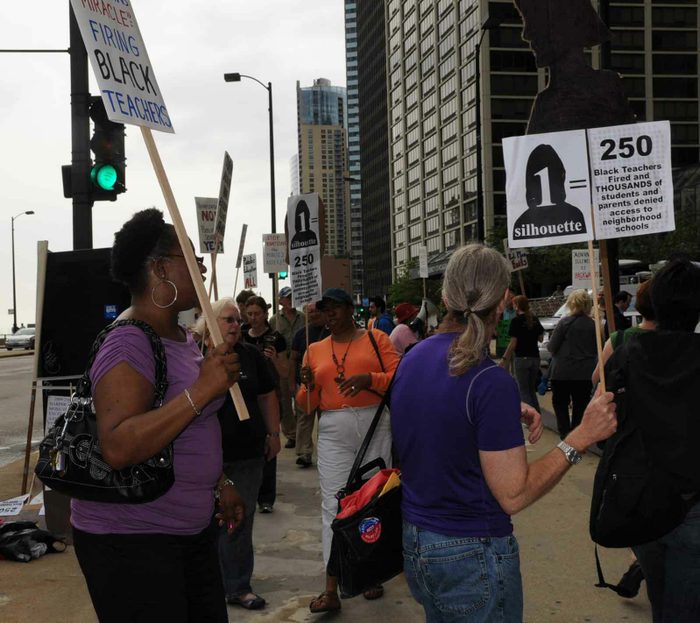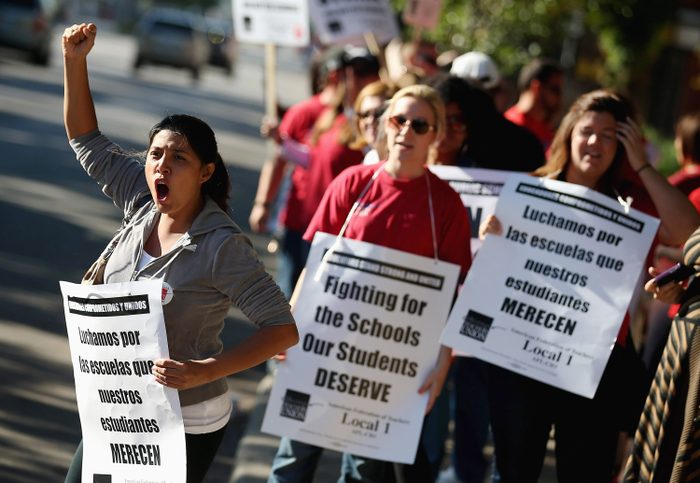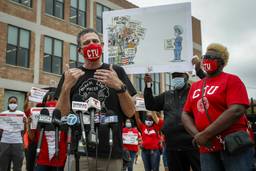On CORE’s 15th Anniversary, Reflecting on the Teachers Caucus That Changed Chicago—and the Nation
The Caucus of Rank-and-File Educators was formed in 2008 when a group of educators and union members came together to transform the Chicago Teachers Union. What they would build would end up changing the city—and country—forever.
Jackson Potter

Twenty years ago, Chicago was in the process of one of the greatest — and most misguided — experiments ever attempted to reform public education in America. It was an effort to completely reshape city schools in the image of the market by emphasizing school-to-school competition, merit-based pay, and a disastrous game of survival of the fittest by closing schools that didn’t test well or meet certain criteria set by the business class. If successful, it would have reshaped Chicago in what would later become the new normal in New Orleans, where the city swapped its public schools for charters after reformers took hold following Hurricane Katrina in 2005.
Chicago mayors have since closed, reconstituted and turned-around (when all staff were fired and rehired) over 200 schools, almost exclusively in the city’s Black communities. This created incalculable harm by exacerbating violence and displacement, greatly undermining confidence in one of our most treasured public institutions. It was over the same period that Chicago Public Schools opened 193 privatized charter, military and contract schools.
In May 2008, as all of this reform was getting underway, myself and Al Ramirez, an elementary school teacher and union delegate from Irma C. Ruiz Elementary School, invited 10 members of the Chicago Teachers Union (CTU) into a spartan room inside the United Electrical Workers union hall, on the Near West Side of Chicago, to consider the state of our union. Many of those present were elected delegates at their schools like Stacy Davis Gates at Roberto Clemente Community Academy, Kenzo Shibata at Lake View High School, Jesse Sharkey, Wendy Boatman and Brian Roa at Senn High School, Jennifer Johnson at Lincoln Park High School, Jose Frausto at Enrico Tonti Elementary School, Norine Gutekanst at Whittier Dual Language School, Jay Rehak from Whitney M. Young Magnet High School, and Kyle Westbrook from Walter Payton College Preparatory High School.
We were frustrated and fed up with the CTU leadership because they did not put up any significant opposition when Mayor Richard M. Daley unleashed the first round of school closings in 2004. For years, community organizations like the Kenwood Oakland Community Organization (KOCO) had called out city officials for the educational apartheid that anchored their efforts to close schools. The first attempt in 2004 was a plan to close 20 of 22 schools in the heart of the city’s Black communities. Many of us had spent years working internally both within our schools and citywide to cajole and encourage union officers and staff to provide organizing support and resources for rank-and-file union members, alongside community allies, to wage a fight against these existential attacks on public education. Those efforts had fits and starts but ultimately failed to generate a significant shift in strategy from the CTU. According to Ramirez, a co-founder of what would become the Caucus of Rank-and-File Educators (CORE), CTU leadership “was not asleep at the wheel, they were joyriding.” Jesse Sharkey, who would later go on to lead the CTU but was then a union delegate at Senn High School, noted at the time that “if we continue down this path, we won’t have a union for much longer.” CORE would go on to hold its first public event on June 7, 2008, which featured a keynote address by Jinny Sims, president of the British Columbia Teachers’ Federation, who shared how the BCTF had won an illegal strike focused on lowering class size in 2005.
A major reason for calling that first meeting was my experience as a union delegate at a predominantly Black school that was callously closed by the district. That school, Englewood High School, was abruptly phased out (allowing existing students to graduate but not accepting any new students) by Arne Duncan, who in 2005 was then CPS CEO. Largely on our own, we organized parents, students and community members to pack school board hearings, share our experiences, and oppose the closing which we knew would destabilize the school community. None of that changed the Chicago Board of Education’s ultimate decision, but the organizing and resistance built a network of educators, parents and community advocates willing to form a new and powerful coalition. That experience launched a 15 plus year collective project to resuscitate the CTU and accelerate the resistance to years of chronic underfunding and the bipartisan effort to close so-called underperforming public schools in the city.
The closing of Englewood was part of a program called Renaissance 2010 (Ren2010), when some of the biggest and wealthiest companies in Chicago called for closing 60-70 schools and opening up some 100 non-union charter and contract schools. Englewood, as one of the oldest Black majority schools in the system with a storied past and graduates like Gwendolyn Brooks and Lorraine Hansberry, was a grand prize. To justify the closing, the Civic Committee of the Commercial Club of Chicago, published “Left Behind: A Report of the Education Committee,” which said there were “too few excellent teachers” and demanded “Chicago should have at least 100 charter schools, located predominantly in inner-city neighborhoods that are served today by mostly failing public schools.”
When Duncan called for the closure of Englewood, the CTU vice president at the time, Ted Dallas, told us to “get your resumes ready.” After Duncan announced Ren2010, based almost verbatim on the Civic Committee’s report, and called Englewood “a culture of failure,” the union tried to counter with a better plan to fix failing schools and remove so-called “bad” teachers. To demonstrate that commitment, the CTU brought in the former president of the Toledo Federation of Teachers, Dal Lawrence, to tell the press that we should immediately terminate 10% of the teaching workforce. Lawrence asserted that the way to improve schools was to make tougher evaluation systems and police ourselves and terminate ineffective teachers. Marilyn Stewart, the CTU president at the time, nodded approvingly. We played the video of the CTU press conference during that May 2008 meeting at the UE hall as the 10 activists gathered there shook their heads in disgust.

We knew then what we know now: If workers want to shape their destiny, we must organize inside the workplaces where we have the most influence and maximize our deep connections as teachers to a broader set of social forces. That was the day we committed to form the Caucus of Rank-and-File Educators as a way to revive the CTU in the mold of a fighting and organizing union, the only thing that could meet the challenges of the moment and set us on a better path forward.
The day after CORE was formed, in order to maximize the number of organizations working to stop Ren2010, we assembled a new coalition called the Grassroots Education Movement (GEM) alongside a host of social movement organizations including KOCO, the Pilsen Alliance, Blocks Together, Action Now, Communities United, Teachers For Social Justice, Designs for Change, Logan Square Neighborhood Association, Brighton Park Neighborhood Council and Parents United for Responsible Education. We called community meetings, led book clubs based on Naomi Klein’s The Shock Doctrine: The Rise of Disaster Capitalism, conducted study groups (often attended by 40 people) on our contract, and developed a constitution for the caucus that stressed community partnerships, democracy, and growing rank-and-file power to defend public education.
We learned from experienced unionists in Los Angeles and British Columbia that we could fight and win against seemingly impossible odds. Based on their advice, we held public events that even CTU leadership was compelled to attend. In the winter of 2009, a CPS insider shared us on a secret list of more schools that the district planned to close and enabled us to organize an event in the middle of a blizzard at Malcolm X College that 500 people attended. These residents came to speak out against the efforts to extinguish their school communities.
We also demonstrated a deep and sustained commitment to “Save our Schools” (a slogan used by GEM on banners and literature) by sleeping outside in the freezing cold to secure our place to speak out at Board of Education meetings and ensure that the public and media knew our story and could popularize a counter narrative of educator and community opposition. We sued the Chicago School Board in a pro-bono case with the Equal Employment Opportunity Commission for the racially disparate impact caused from firing a disproportionate number of Black educators at Black schools. We studied the school budget and testified at CPS budget hearings about the ways neighborhood schools were being starved while privatized and selective enrollment schools received more resources. In other words, we built a “union in the community” meeting by meeting and event after event.
These years of frenetic activity and careful planning set the stage for the CTU leadership election two years later in 2010, when legendary former CTU President Karen Lewis and our officer and executive board slate swept the incumbents out of power in a runoff election. The results represented a sea change in the history of public education and the teacher union movement.
When Rahm Emanuel was elected mayor in 2011, the CTU’s newly elected leadership knew we would have to become strike ready and curtail his efforts to legislate away our right to strike. Emanuel led an effort that resulted in a bill that made it impossible to strike unless 75% of our existing members authorized it. He then attempted to lengthen the school day by 20% without commensurate pay or resources. This created an incentive to achieve maximum unity, a standard we easily surpassed. To add insult to injury, Emanuel attempted to eviscerate an agreement forged from 70 years of bargaining history by turning a 300-plus page contract into a 50-page document stripped of rights that educators had endured multiple strikes in the 1970s and ’80s to win. As a result, we cleared the hurdle with over 90% of members voting to authorize a strike. Emanuel continued to demonize us by claiming “Teachers got a raise, children got the shaft” in a front page article in the Chicago Sun-Times, all but ensuring that a strike would be necessary.

Today, the CTU’s 2012 strike is often referenced as the dawn of an approach to contract negotiations known as Bargaining for the Common Good (BCG). While we started with more traditional proposals for lower class sizes and increased staffing, we experimented with demands for progressive revenue, equitable use of the Tax Increment Financing program and a teacher home visit program modeled after the Saint Paul Federation of Educators. By 2015, we expanded those efforts and submitted proposals to pay $15 an hour to all school district employees, even those outside our own membership. The solidarity with the Fight for $15 campaign is one example of what Stephen Lerner, one of the founders of the BCG network and an architect of SEIU’s Justice for Janitors campaign, has argued is a necessary innovation in how unions must use their leverage to advance broader societal demands. Another example of this approach was the CTU’s demand for affordable housing for all of Chicago’s 20,000 homeless students during our 2019 strike.
More and more unions are adopting BCG approaches as a result. In 2020, more than 4,000 janitors in Minneapolis in SEIU Local 26 led a strike that focused in large part on environmental justice demands.
“The Minneapolis janitors became the first U.S. union to go on strike for climate justice. … Local unions across the country have responded to the global pandemic by articulating demands that meet the needs of their members and the communities they live and work in,” according to a March 2020 article in The Forge by Todd E. Vachon, Gerry Hudson, Judith Le Blanc and Saket Soni. Los Angeles teachers recently settled an agreement that similarly ramps up environmental justice provisions in their new contract, following a tradition started in the education sector during the 2012 strike.”
That 2012 CTU strike encouraged teacher union locals across the nation, including those in red states without formal bargaining rights to fight back. The last decade represents the most successful organizing project that the labor movement has experienced in a generation. Community and union forces banded together and raised issues about inequitable funding, passed initiatives for progressive revenue that turned back decades of austerity that took the form of cuts to educational spending, and in some cases exposed educational apartheid in their advocacy and demands. The movement permanently disrupted the bipartisan neoliberal privatization agenda that produced record school closures, budget cuts, and the expansion of non-union charter schools.
No fewer than 25 teacher strikes in the past 10 years were launched to roll back the ongoing attacks on public education. The strikes have injected hope and momentum into the labor movement. From Arizona to West Virginia to Minneapolis, teachers waged city-based and state-wide strikes that led to unprecedented victories in school investment, class sizes, staffing formulas, and common good demands after decades of underfunding, privatization, and demonization of public school teachers and staff. As scholar Eric Blanc has noted, “a total of 425,000 workers struck in 2019, with a strong majority (270,000) again coming from the education sector. And this number does not include the numerous examples of school districts such as Las Vegas, where unions organized credible strike threats but management avoided walkouts by granting major last-minute concessions.”
In many of these efforts, teachers won because they have run strong contract campaigns focused on what organizer and author Jane McAlevey has referred to as “structure tests,” such as trying to ramp up the number of members wearing red of Fridays, engaging in informational pickets with parents, attending citywide rallies and events, all culminating in strike votes and strike action. Organizers engaged every member to take part in escalating actions that advanced a clear set of public good demands.
In 2018, numerous reports portrayed the West Virginia, Oklahoma, Arizona and Kentucky school walkouts as an extension of the new community orientation of the teacher union response to budget cuts and efforts to expand privatized school options. A renewed sense that collective action could turn the table on decades-long attacks against public education. Many activists see the CTU’s strike in 2012, and the formation of CORE in 2008, as initial flashpoints that set the course for these later actions. For example, Rebecca Garelli, a strike captain at Talcott Elementary School in 2012, went on to lead the Red for Ed statewide strike actions in Arizona years later as a science teacher. Additional evidence of CORE and CTU setting the stage was the proliferation of locals demanding a similar set of aspirational goals. Reports titled “The Schools Saint Paul Children Deserve” and “Schools LA Students Deserve” and “Schools Oakland Students Deserve” were all modeled after our 2012 report titled “The Schools Chicago’s Students Deserve.” Additionally, the strike created a wave of new rank-and-file teacher caucuses across the country like the Baltimore Movement of Rank-and-File Educators, the New York Movement of Rank-and-File Educators, the Caucus of Working Educators in Philadelphia and a national network called the United Caucuses of Rank-and-File Educators (UCORE) coordinated by Labor Notes.

Most of the demands advanced by educators in red states like Kentucky, West Virginia, Oklahoma, North Carolina and Arizona went beyond the narrow confines of traditional bargaining and often included the needs of public school families and even other workers. Though formal collective bargaining is prohibited in West Virginia, teachers there refused to end their strike until all of the state’s employees received the same raise they had been promised. Additionally, Arizona teachers organized for a ballot initiative that would block tax cuts that had defunded their schools, while North Carolina teachers called for Medicaid expansion.
In April 2023, a majority of Chicago voters opted to elect a new mayor, Brandon Johnson, an educator and CTU organizer who had been a key player in the fight against school closings and austerity. His election was a testament to the damage done by school closings and the rejection by voters of the neoliberal school agenda. For example, Emanuel’s popularity plummeted in the aftermath of his 50 school closings in 2013. As local school council co-chair of Harper High School, Clifford Fields, stated during the 2017 fight against the last round of school closings, “If these schools have to go, the mayor has to go.”
The last 20 years of education reform policy have focused on privatization and destabilization of public schools in Chicago and nationally — and Chicago helped lead the way in the resistance to it. Now, with the election of a CTU member and middle school teacher as mayor of the nation’s third largest city, the Johnson administration can build on the work of CORE and the new CTU to bring forth a new era of investment and support for sustainable community school districts that foster equity over competition.
Happy 15th birthday CORE — we needed you then, we need you now — may the next 15 years bring similar advances and victories.
As a high school student in Chicago in 1995, Jackson Potter led a walk-out to push for equitable school funding in Illinois. He later taught at Englewood High School and was the union delegate there when the district slated the school for closure. He and Al Ramirez formed the Caucus of Rank and File Educators (CORE) in 2008 and the Grassroots Education Movement (with other community organizations) shortly after. He and future Chicago Teachers Union president Karen Lewis served together as the first co-chairs of CORE. After working as CTU’s staff coordinator for eight years, Jackson went back to teaching from 2018 to 2022 and now serves as the union’s vice president.








